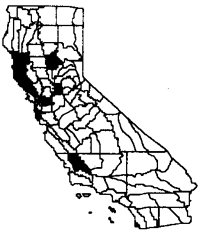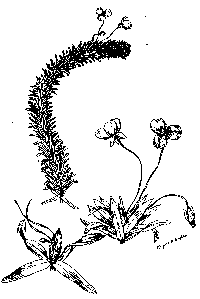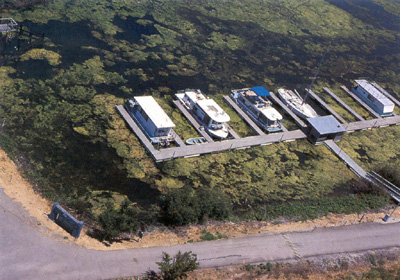|
Egeria densa
|
|
|
|
Scientific name
|
Egeria densa
|
|
Additional name information:
|
Planchon
|
|
Common name
|
egeria, leafy elodea, dense waterweed, Brazilian waterweed, anacharis, Brazilian elodea
|
|
Synonymous scientific names
|
Anacharis densa, Elodea canadensis gigantea, Elodea densa
|
|
Closely related California natives
|
Elodea canadensis, E. nuttallii
|
|
Closely related California non-natives:
|
none
|
|
Listed
|
CalEPPC List A-2,CDFA nl
|
|
By:
|
Lars Anderson,Marc C. Hoshovsky
|
|
Distribution
|
|
HOW DO I RECOGNIZE IT?
Distinctive features:
|
Egeria (Egeria densa) is a
perennial freshwater aquatic herb in the waterweed family. It has stems up to
fifteen feet long that are frequently branched. It is distinguished from related
species by the absence of turions (shoots from underground stems) and tubers and
by the presence of showy, white flowers that float on or just above the water.
It is usually rooted in bottom mud, but may be found as a free-floating mat or
fragments with its buoyant stems near the surface.
åÊ
|
|
Description:
|
| Hydrocharitaceae. Aquatic perennial. Stems: Green to brown, slender 0.1 in (2-3 mm) thick, generally branched but long 10-16 ft (3-5 m). Leaves: opposite below, crowded and whorled above, 3 to 6 leaves per whorl, each narrowly oblong, 0.4-1.2 in long by 0.1-0.2 in wide (1-3 cm by 2-5 mm) and sessile with a finely serrate margin. Flowers: white, large, unisexual, exserted from sessile, +/- ovate, 2-toothed spathes formed in axils of upper leaves and carried to the surface on a thread-like extension of the perianth tube up to 3 in (8 cm) long. |
|
Female flowers solitary, with 3 spoon-shaped
sepals, reflexed at maturity, and 3 broadly ovate but unequal sepals 0.2-0.3 in
(6-8 mm) long and 0.2-0.3 in (5-8 mm) wide. Male flowers are in groups of 2-4
with 3 boat-shaped sepals and 3 showy petals 0.35-0.4 in (9-11 mm) long and
0.2-0.35 in (6-9 mm) wide. Fruits: cylindrical, 0.3 in (7-8 mm) long and 0.1 in
(3 mm) diameter, developing within the female spathe; rare or absent in CA
populations. Seeds: if present, spindle-shaped and 0.3 in (7-8 mm) long (Hickman
1993, Parsons 1992).
åÊ
|
|
WHERE WOULD I FIND IT?
|
Egeria occurs in cool to warm freshwater
ponds, lakes, reservoirs, and slowly flowing streams and sloughs. It can root up
to seven meters below the water surface (Parsons 1992). In California, egeria
occurs at less than 7,000 feet elevation in the Sierra Nevada, Central Valley,
central coast San Francisco Bay, and San Jacinto Mountains (Hickman
1993).
åÊ
|
|
WHERE DID IT COME FROM AND HOW IS IT SPREAD?
|
Egeria is native to Argentina, Brazil, and
Uruguay. It is has been distributed via the aquarium trade to many other parts
of the world, including Chile, Mexico, the United States, England, New Zealand,
and Australia, where it has escaped cultivation and become naturalized (Parsons
1992). The timing and location of its entry into California are unknown. Human
dispersal via the aquarium trade is the most common means of egeria dispersal
(Parsons 1992) and it can readily establish in natural water bodies after
escaping from human settings. Once naturalized, egeria can spread along existing
water courses into suitable new habitats without further human activity. Stem
fragments at least two nodes long frequently break off and float away from the
parent plant during active growth in spring (Parsons 1992). Fragments occur
during all times of the year as a result of mechanical shearing of water flows,
wave action, waterfowl activity, and boating.
åÊ
|
|
WHAT PROBLEMS DOES IT CAUSE?
|
EgeriaÛªs dense underwater growth
significantly retards water flow, interfering with irrigation projects,
hydroelectric utilities, and urban water supplies. It may also slow water
traffic and interfere with recreational and commercial activities such as
boating, swimming, and fishing. Egeria reduces the abundance and diversity of
native plant seeds in lake bottoms, and this is probably accentuated by
increased sediment accumulation beneath the weed beds (deWinton and Clayton
1996).
åÊ
|
|
HOW DOES IT GROW AND REPRODUCE?
|
In California (and North America in general) reproduction and dispersal are via fragments of shoots and rhizomes, since only the male plant has become established. No seed formation has been documented (Anderson 1997, 1998, and pers. observation). Stem fragments can take root in bottom mud or may remain as free-floating mats. Roots range from fine and thread-like to long, thick, and robust adventitious roots, with many branches. Growth is most rapid during summer, as day length and temperature increase. Biomass in lakes reaches a maximum during late summer and fall. Thick mats form, consisting of long, intertwining, multi-branched stems below the water surface. No information is available on the rate of individual plant growth (Parsons 1992).
|
EgeriaÛªs ecological requirements are poorly investigated, although its nutrient and light requirements are similar to other members of the family. Its growth appears to be affected by nutrient status, light intensity, day length, temperature, and rate of water flow. It tolerates a wide range of nutrient levels, particularly phosphorus. Biomass increases with increased ammonium in stream water and with total nitrogen in sediments.
|
(click on photos to view larger image)
|
Egeria has a low light requirement. High
light intensities cause discoloration and damage to the chlorophyll within about
two weeks. Thus, turbid water is likely to favor rather than inhibit growth.
Egeria thrives in red light spectra, which is more abundant near the water
surface, and is killed or suffers under blue and green light spectra, which
penetrate deeper below the surface. This may explain why the weed cannot
establish itself more than twenty feet below the water surface (Feijoo et al.
1996).
åÊ
|
|
HOW CAN I GET RID OF IT?
|
Several methods are useful in removing
egeria, particularly in lakes and ponds where water movement is
minimal.
åÊ
|
|
Physical control:
|
Manual/mechanical methods: pulling, cutting,
and digging with machines is costly, provide only temporary relief, and
simultaneously encourage spread by fragmentation. Mechanical harvesting produces
thousands of viable fragments per acre (Anderson, 1998).
åÊ
|
|
Biological control:
|
Grazing: Two fish, the white amur or Chinese
grass carp (Ctenopharyngodon idella) and the Congo tilapia (Tilapia
melanopleura), have been introduced into water bodies to control egeria
(Avault 1965). Currently, only the sterile (triploid) grass carp can be used in
California and only in six southern California counties (Imperial, San Diego,
Riverside, San Bernardino, Los Angeles, and Ventura). Permitted uses are
authorized by the California Department of Fish and Game throughout the state
with certain restrictions.
åÊ
|
|
Chemical control:
|
Herbicides in aquatic systems must be handled
carefully to avoid worsening the situation. A specialist in control of aquatic
weeds should be consulted. At present the following herbicides can be used at
label concentrations to control egeria in California: diquat (contact type);
copper-containing products (contact type); acrolein (contact type and highly
restricted uses where no fisheries are impacted); and fluridone (systemic type
requiring 4 to 6 weeks of treatment at very low rates) (Anderson et al.
1996).
åÊ
|




